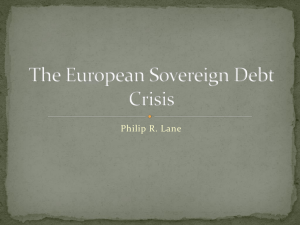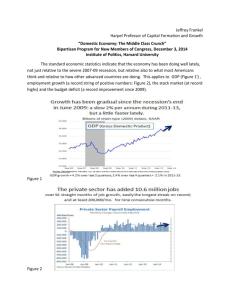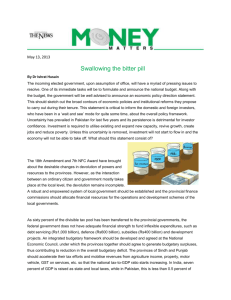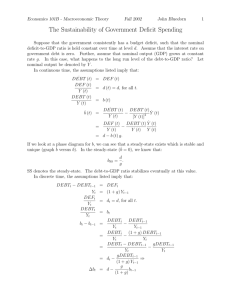Debt accumulation, stability and Fiscal Policy
advertisement
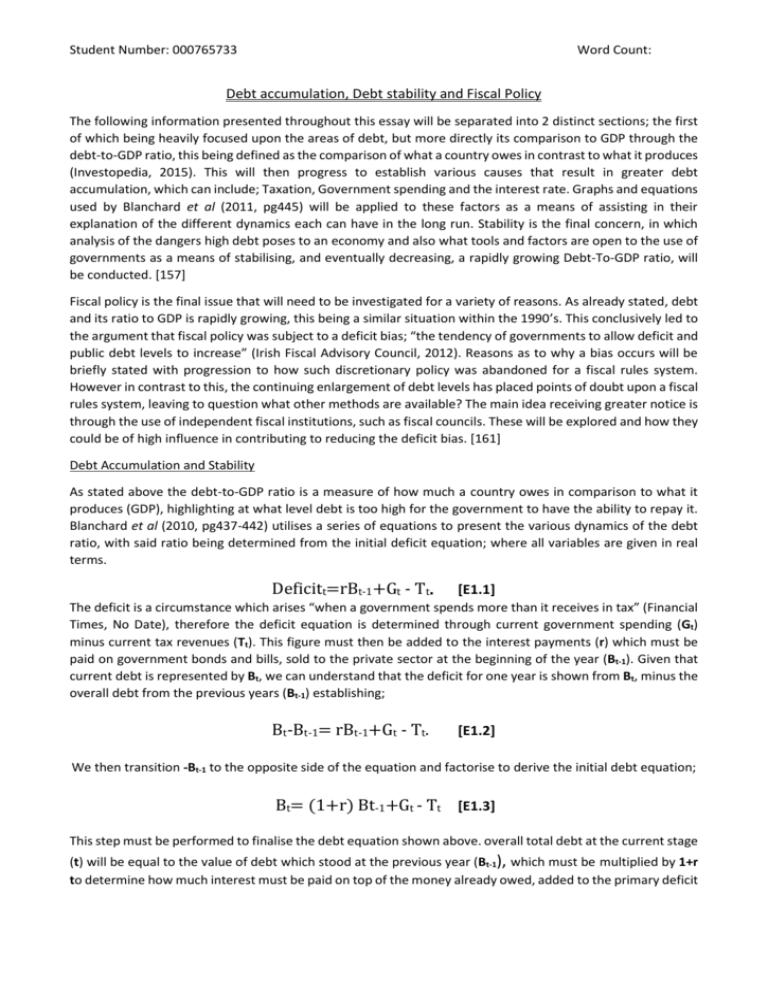
Student Number: 000765733 Word Count: Debt accumulation, Debt stability and Fiscal Policy The following information presented throughout this essay will be separated into 2 distinct sections; the first of which being heavily focused upon the areas of debt, but more directly its comparison to GDP through the debt-to-GDP ratio, this being defined as the comparison of what a country owes in contrast to what it produces (Investopedia, 2015). This will then progress to establish various causes that result in greater debt accumulation, which can include; Taxation, Government spending and the interest rate. Graphs and equations used by Blanchard et al (2011, pg445) will be applied to these factors as a means of assisting in their explanation of the different dynamics each can have in the long run. Stability is the final concern, in which analysis of the dangers high debt poses to an economy and also what tools and factors are open to the use of governments as a means of stabilising, and eventually decreasing, a rapidly growing Debt-To-GDP ratio, will be conducted. [157] Fiscal policy is the final issue that will need to be investigated for a variety of reasons. As already stated, debt and its ratio to GDP is rapidly growing, this being a similar situation within the 1990’s. This conclusively led to the argument that fiscal policy was subject to a deficit bias; “the tendency of governments to allow deficit and public debt levels to increase” (Irish Fiscal Advisory Council, 2012). Reasons as to why a bias occurs will be briefly stated with progression to how such discretionary policy was abandoned for a fiscal rules system. However in contrast to this, the continuing enlargement of debt levels has placed points of doubt upon a fiscal rules system, leaving to question what other methods are available? The main idea receiving greater notice is through the use of independent fiscal institutions, such as fiscal councils. These will be explored and how they could be of high influence in contributing to reducing the deficit bias. [161] Debt Accumulation and Stability As stated above the debt-to-GDP ratio is a measure of how much a country owes in comparison to what it produces (GDP), highlighting at what level debt is too high for the government to have the ability to repay it. Blanchard et al (2010, pg437-442) utilises a series of equations to present the various dynamics of the debt ratio, with said ratio being determined from the initial deficit equation; where all variables are given in real terms. Deficitt=rBt-1+Gt - Tt. [E1.1] The deficit is a circumstance which arises “when a government spends more than it receives in tax” (Financial Times, No Date), therefore the deficit equation is determined through current government spending (Gt) minus current tax revenues (Tt). This figure must then be added to the interest payments (r) which must be paid on government bonds and bills, sold to the private sector at the beginning of the year (Bt-1). Given that current debt is represented by Bt, we can understand that the deficit for one year is shown from Bt, minus the overall debt from the previous years (Bt-1) establishing; Bt-Bt-1= rBt-1+Gt - Tt. [E1.2] We then transition -Bt-1 to the opposite side of the equation and factorise to derive the initial debt equation; Bt= (1+r) Bt-1+Gt - Tt [E1.3] This step must be performed to finalise the debt equation shown above. overall total debt at the current stage (t) will be equal to the value of debt which stood at the previous year (Bt-1), which must be multiplied by 1+r to determine how much interest must be paid on top of the money already owed, added to the primary deficit Student Number: 000765733 Word Count: (or potential surplus) (Gt- Tt) accumulated over the year; this being the deficit but subtracting interest payments (Blanchard et al, 2010, pg439) to formulate the current amount of money owed by an economy. Now debt has been derived we can introduce the component of output (Y) to represent GDP, allowing us to progress to derive the debt-to-GDP ratio and outlining its dynamics, many of which Blanchard et al (2010, pg442-445) highlights. In terms of equation we divide the equation through by output for the current year (Yt); 𝐁𝐭 𝐘𝐭 = (𝟏 + 𝐫) 𝐁𝐭−𝟏 𝐘𝐭 + 𝐆𝐭 −𝐓𝐭 [E1.4] 𝐘𝐭 We then rewrite Bt-1/Yt into two separate fractions to create an easier form, introducing output in the previous year (Yt-1); 𝐁𝐭 𝐘𝐭 = (𝟏 + 𝐫)( 𝒀𝒕−𝟏 𝒀𝒕 ) 𝐁𝐭−𝟏 𝐘𝐭−𝟏 + 𝐆𝐭 −𝐓𝐭 𝐘𝐭 [E1.5] We can then progress to simplify this formula by introducing the growth rate of output (g) as so; 𝒀𝒕−𝟏 𝒀𝒕 = 𝟏 𝟏+𝒈 This can then be substituted into equation E1.5, in which 1/(1+g) is multiplied by (1+r) to formulate (1+r)/(1+g). We are then able to approximate this function (best suited when g and r are relatively small) with the following formula; 1+r-g. Now this is approximated we substitute this back into our altered E1.5 equation to arrive at the following; 𝐁𝐭 𝐘𝐭 = (𝟏 + 𝐫 − 𝐠) 𝐁𝐭−𝟏 𝐘𝐭−𝟏 + 𝐆𝐭 −𝐓𝐭 𝐘𝐭 [E1.6] To finalise our debt-to-GDP ratio equation we expand Bt-1/Yt-1 with the 1 of the (1+r-g) formula and move this to the left side of the equation. This final formula shown in E1.7 below, expresses that the total debt-to-GDP ratio is equal to two sums; the first of which being the “difference between the real interest rate and the rate of growth of GDP” (Blanchard et al, 2010, pg442) as they have contrasting effects on the ratio. The second being the primary deficit in terms of GDP. 𝐁𝐭 𝐘𝐭 − 𝐁𝐭−𝟏 𝐘𝐭−𝟏 = (𝐫 − 𝐠) 𝐁𝐭−𝟏 𝐘𝐭−𝟏 + 𝐆𝐭 −𝐓𝐭 𝐘𝐭 [E1.7] Being the Debt-ratio equation is derived, we can now incorporate graphs (utilised in Blanchard et al (2010, pg445-446)) to analyse the dynamics of this Debt-to-GDP ratio. They are formed from differentiating an altered E1.6 equation, where time t is given in the period before (As this form is easier to differentiate). This is done by keeping (Gt-Tt)/Yt constant, this assuming a constant deficit (or surplus) is maintained, and also (1+r-g) as constant. 1+r-g is used as the slope with (Gt-Tt)/Yt being the intercept. Student Number: 000765733 Word Count: Debt accumulation can be difficult to control, especially in times of approaching recession as increased government expenditure is more often required to avoid this downturn, such was the case in Brazil for the 3rd quarter of last year (Cascione, 2014). However if continuing deficits are not managed correctly and this continuously pushes debt further, it can pose numerous problems. REASONS FOR DEFICIT BIAS; : (i) informational problems; (ii) impatience; (iii) exploiting future generations; (iv) electoral competition; (v) common-pool theory; and (vi) time inconsistency. Reference List Cascione, S (2014) Hefty Government Spending Ends Brazil’s Recession, For Now. [Online] Available from: http://www.reuters.com/article/2014/11/25/us-brazil-economy-gdp-idUSKCN0J91UO20141125 (Date Accessed: 15/01/15 Financial Times (No Date) Definition of Structural Deficit. [Online] Available from: http://lexicon.ft.com/Term?term=structural-deficit (Date Accessed: 17/01/15) Investopedia (2015) Debt-To-GDP Ratio. [Online] Available from: http://www.investopedia.com/terms/d/debtgdpratio.asp (Date Accessed: 15/01/15) Irish Fiscal Advisory Council (2012) Fiscal Assessment Report. [Online] Available from: http://www.fiscalcouncil.ie/wp-content/uploads/2012/09/FAR_Sept2012.pdf (Date Accessed: 15/01/15) Things to do ATE Student Number: 000765733 1. Find journal definition for debt-GDP ratio Word Count:


